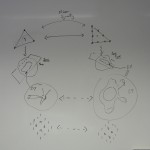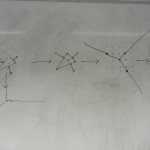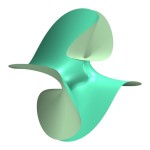What are these Forms called Calabi-Yau Manifolds?
Calabi-Yaus’ are slices of Fano Form Varieties. Theoretical Physicians and Mathematicians believe that there are not just the three dimensions plus time (four dimensions we experience) but seven more dimensions, thats’ eleven dimensions, and it could be more! The higher dimensions are so small that we cannot see them.
Higher Dimensions are believed to be composed of strings, which are the smallest and most basic things that exist in the universe, and these higher dimensions curl or fold as Calabi-Yaus’ forms, and through these colabi-yau forms, mathematicians can develop string theories.
Strings are one-dimensional and oscillate at different frequencies. String theory is the theory of the nature and behaviour of these strings and if successful will unify the two biggest theories of the 20th century: The theory of relativity, which is the theory of objects that are relatively large and governed by the laws of gravity (orbiting space stations), and Quantum Field Theory, which is the theory of the behaviour of Atoms and anything smaller, which are seemingly unaffected by gravity (computers, lazers). String theory hopes to work as a theory for the micro and the macro, and therefore give us a better theory of the universe.
One of the ways that string theorists are trying to do this is related to the Big Bang. String Theorists believe that when the Big Bang happened, the universe was really small (it should really be called the small bang). Relatively the strings that we now believe to be the smallest existing things, where much bigger and may have left an “impression” on the way the galaxy has developed. Searching for these traces may help to develop String Theory.
The mathematical process to calculate a Calabi-Yau form begins with a Polyhedra, the images above are drawings by a mathematician at Imperial College who was explaining this process to me.




